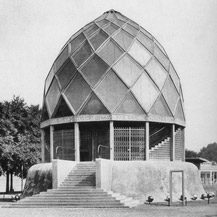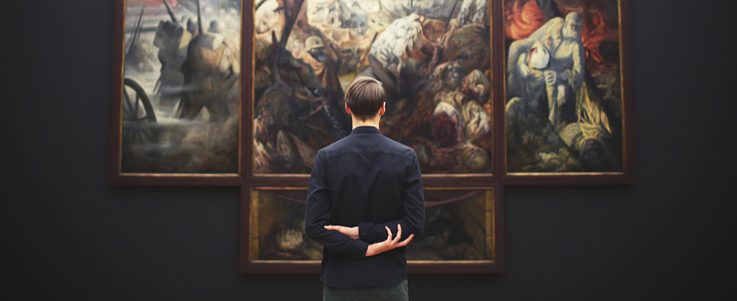Hundreds of thousands of international tourists come annually to visit the Bauhaus building in Dessau. Designed by Walter Gropius and built in 1926, the building can be found in every standard work on the history of architecture. It has continued to do justice to the images that have been circulating around the world for ninety years: it is still agelessly beautiful.
Its environment, its institutional structure, its users and guests, its operations, and its heating have all changed. The glass building housed the College of Design for only six years, followed by a varied and dramatic history of closure, partial destruction and temporary use, until the rebuilt building reopened in 1976 for the 50th anniversary of the German Democratic Republic — and after its establishment as a foundation in reunified Germany, was added to World Heritage List.
The radicalism of the Bauhaus building is mainly associated with its method of construction: the horizontal, movement-emphasizing organization of its main body, but above all its glass curtain wall. The almost-floating, dematerialized workshop wing, free of the heaviness of the supporting wall, astonished visitors at the time. The fascination can be traced to the fact that, when moving through the rooms, what was beginning to structure life in the 1920s became almost tangible: the traditionally constructed environment of the Wilhelminian era no longer seemed to fit the simultaneity of media images and messages, the acceleration of everyday life, the compression of social experience and spatial relations. Glass buildings not only expressed the enthusiasm of the architects for this construction material, they also embodied a new, modernist everyday culture.
Yet glass buildings were no novelty: in 1911, Gropius had already designed a curtain wall for the Fagus shoe last factory in Ahlfeld.
 External view of the Glashaus-Pavillon | © Unbekannt, Wikipedia, edited, CC0-1.0
In 1914, Bruno Taut presented his glass pavilion at the Werkbund exhibition in Cologne. Five years later, in the aftershock of the November Revolution, Taut initiated the correspondence circle The Glass Chain (Die Gläsernen Kette): in it, artists, writers and architects such as Paul Scheerbart, Wenzel Hablik, Hans Scharoun, and Walter Gropius exchanged utopian reflections. In drawings and texts, they proposed a new architecture, created from the transparent, spiritual qualities of glass, making reference to Gothic cathedrals.
External view of the Glashaus-Pavillon | © Unbekannt, Wikipedia, edited, CC0-1.0
In 1914, Bruno Taut presented his glass pavilion at the Werkbund exhibition in Cologne. Five years later, in the aftershock of the November Revolution, Taut initiated the correspondence circle The Glass Chain (Die Gläsernen Kette): in it, artists, writers and architects such as Paul Scheerbart, Wenzel Hablik, Hans Scharoun, and Walter Gropius exchanged utopian reflections. In drawings and texts, they proposed a new architecture, created from the transparent, spiritual qualities of glass, making reference to Gothic cathedrals.
In his reflections on the "poverty of experience" as a signature of the times, Walter Benjamin cites Paul Scheerbart, who envisioned people housed in moving dwellings made of glass. After all, glass is, according to Benjamin, "a hard and smooth material on which nothing fixes"; in the new "glass culture", he argued, in which the Bauhaus also participated, spaces were created in which it was difficult to "leave traces".1 It was also Benjamin who described nineteenth century popular glass architecture – train stations, exhibition halls, and department stores – as "dream houses of the collective". In glass buildings, a new modernist culture, which envisaged a classless society, was forging ahead.
In these highly charged cultural debates, the Bauhaus building was perceived as a utopia materialized in glass and stone, open to interpretation by a wide variety of ideological camps. If modern media cultures were decisively influential for building with glass, films, magazines, books, exhibitions, and photographs contributed to its international dissemination. In the book International Architecture, published in 1927, Gropius presented pictures of the Bauhaus building together with international examples of a new world-wide architectural ethos. The iconic images by the photographer Lucia Moholy contributed to popularizing a particular convention of viewing the building. Her photos of it were also on display at the 1927 exhibition Machine Age, the first comprehensive show of international avant-garde art and architecture in New York.
Alfred Barr, fascinated by this modernist architecture, visited the Bauhaus on his European tour. This encounter inspired not only the founding of the Museum of Modern Art in 1929, whose first director Barr was, but also the idea of organizing an exhibition of this new "architectural style" in New York.
Together with Philip Johnson and Henry Russell Hitchcock, Barr undertook further travels to compile material for a publication on contemporary architecture entitled The International Style. Architecture since 1922. The classification of European buildings by Hitchcock, based on formal stylistic criteria and the associated omission of the political and social contexts of the New Architecture, shaped the 1932 Modern Architecture. International Exhibition. The show marks a milestone in the canonization and popularization of the Bauhaus building as a style to whose features – modular regularity, renunciation of ornamentation, and dissolution of the massive structural shell in favor of an architecture of space – the glass curtain wall decisively contributed.2 That the German emigrants Walter Gropius, Marcel Breuer, and Mies van der Rohe, who moved to the United States a few years later, accepted this popularization and reinterpretation of New Architecture, probably had something to do with their status as exiles and the effort to gain recognition in a foreign land.
 Facade of the Bauhaus building in Dessau, 2018
| Wikipedia, edited, CC-BY-SA-4.0'
Facade of the Bauhaus building in Dessau, 2018
| Wikipedia, edited, CC-BY-SA-4.0'
In the immediate post-war period, glass buildings became the American trademark of powerful representatives of large companies: the Lever Building by SOM (1952) and the Seagram Building by Mies van der Rohe (1958), both in New York, are signature examples of this change from experiment to mainstream.
Economic boom, mass consumption and corporate capitalism in the geopolitical context of the Cold War assigned the buildings made of glass a different meaning. The elegant, sleek, technically perfect facades not only manifested the ethos of the rise and success of large corporations, but also organized their operations and gave them an aesthetic form. Yet, divested of the utopian ideas of the early years, they became the glass shells of American diplomatic buildings and hotels that were built around the world as instruments of cultural statecraft and landmarks of Western freedom, democracy, and cultural superiority.3 Curtain walls soon became the standard repertoire of the construction industry in the United States. The curtain wall was on offer even in Sweet’s Catalogue, the catalogue of one of the leading hardware stores of those years. It is therefore not surprising that architectural magazines reinterpreted the former European import in terms of American vernacular architecture.
Thus the reintegration of glass buildings into post-war Germany was charged with being the normative architecture, the counterpoint to the monumentality of National Socialism and the symbol of commitment to the Western values of freedom and democracy. The Dreischeiben skyscraper in Düsseldorf, built in 1957 by the architects Hubert Petschnigg and Helmut Hendrich for the Phoenix Rheinrohr AG, is an early testimony to these renewed transatlantic conversations along the curtain wall.
 Bauhaus-Logo | © Oskar Schlemmer, Wikipedia, edited, CC0-1.0
Yet, despite the complicity with capitalism, the Cold War, and commerce, the promise of social advancement and prosperity was encoded in the DNA of the glass curtain facades of those years. The promise of modernist transparency was first broken only by the chic, post-modern mirror facades of John Portman. In the end, those emblems of neoliberal global finance capitalism, the thin banking towers wrapped in glass skins from Dubai to New York and from Shanghai to London, have taken over from their forefathers only the idea of the freedom of cash flow.
Bauhaus-Logo | © Oskar Schlemmer, Wikipedia, edited, CC0-1.0
Yet, despite the complicity with capitalism, the Cold War, and commerce, the promise of social advancement and prosperity was encoded in the DNA of the glass curtain facades of those years. The promise of modernist transparency was first broken only by the chic, post-modern mirror facades of John Portman. In the end, those emblems of neoliberal global finance capitalism, the thin banking towers wrapped in glass skins from Dubai to New York and from Shanghai to London, have taken over from their forefathers only the idea of the freedom of cash flow.
1 Benjamin, Walter, "Erfahrung und Armut," in Gesammelte Schriften, vol. 2, Walter Benjamin (Frankfurt/Main, 1991) p. 213.
2 Thöner, Wolfgang, "Austreibung des Funktionalismus und Ankunft im Stil," in Bauhausstil zwischen International style und Lifestyle, ed. Regina Bittner (Berlin, 2003), p. 121.
3 Ockman, Joan, "Towards a theory of normative architecture," in Steven Harris and Deborah Berke (eds.), Architecture of the Everday, (Princeton, 1997), p. 131.
To the Overview



